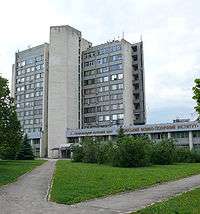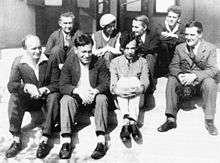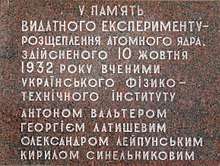Kharkiv Institute of Physics and Technology
The National Science Center Kharkiv Institute of Physics and Technology (KIPT) (Ukrainian: Національний науковий центр «Харківський фізико-технічний інститут», formerly Ukrainian Institute of Physics and Technology) is the oldest and largest physical science research centre in Ukraine.[1] Today it is known as a science center as it consists of several institutes that are part of the Kharkiv Institute of Physics and Technology science complex.

History


The institute was founded on 30 October 1928, by the Government of Soviet Ukraine[2] on an initiative of Abram Ioffe on the northern outskirts of Kharkiv (in khutir Piatykhatky) as the Ukrainian Institute of Physics and Technology for the purpose of research on nuclear physics and condensed matter physics. Note that Kharkiv at that time was the capital of Soviet Ukraine. An opening of the institute precisely in Kharkiv had an ideological implication: At height of being defeated by the Russian Red Army, the "samostiynyky"[lower-alpha 1] of various modifications who laid at the basis of Ukrainian national consciousness their culture of the past, the Soviet Ukraine has implemented new culture based on advanced achievements of the human intellect and modern technologies rather than on sharovary (Ukrainian traditional dress), folk songs, and oseledets (Ukrainian Cossack hairstyle).[2]
From the moment of its creation, the institute was run by the People's Commissariat of Heavy Industry.[2]
On 10 October 1932 the first experiments in nuclear fission in the Soviet Union were conducted here. The Soviet nuclear physicists Anton Valter, Georgiy Latyshev, Cyril Sinelnikov, and Aleksandr Leipunskii used a lithium atom nucleus. Later the Ukrainian Institute of Physics and Technology was able to obtain liquid hydrogen and helium. They also constructed a radar station, and the institute became a pioneer of the Soviet high vacuum engineering which was developed into an industrial vacuum metallurgy.
During the Stalin epoch, this was where the UPTI Affair occurred in 1938: three leading physicists of the Kharkiv Institute (Lev Landau, Yuri Rumer and Moisey Korets) were arrested by the Soviet secret police.
The Ukrainian Institute of Physics and Technology was the "Laboratory no. 1" for nuclear physics, and was responsible for the first development of a nuclear bomb in the former USSR.
Directors
- 1929 — 1933 Ivan Obreimov
- 1933 — 1934 Aleksandr Leipunskii
- 1934 — 1936 Semyon Davidovich
- 1936 — 1938 Aleksandr Leipunskii
- 1938 — .... ?
- 1944 - 1965 Cyril Sinelnikov
- 1965 - 1980 Victor Ivanov
- 1980 - 1996 Viktor Zelensky
- 1996 - 2004 Vladimir Lapshin
- 2004 - 2017 Ivan Neklyudov
- 2017 — Nikolay Shulga
Important institutes
Science and education institutions in Pyatykhatky.
Kharkiv Institute of Physics and Technology
- The Lev Shubnikov Low Temperature Laboratory at the Ukrainian Institute of Physics and Technology was founded in 1931. Lev Shubnikov was a head of the cryogenic laboratory at the Ukrainian Institute of Physics and Technology in 1931–1937. In 1935, Rjabinin, Schubnikow experimentally discovered the Type-II superconductors at the cryogenic laboratory at the institute.[3][4]
- Institute of condensed matter physics, materials studies and technology
- Plasma physics institute, Institute of high energy and nuclear physics
- Institute of plasma electronics and new methods of acceleration
- Akhiezer Institute of theoretical physics
Other institutes
- Kharkiv University faculty of physics and technology, located nearby.
Notable alumni
- Aleksander Akhiezer
- Naum Akhiezer
- Semion Braude
- Dmitri Ivanenko
- Fritz Houtermans
- Arnold Kosevich
- Eduard Kuraev
- Igor Kurchatov
- Lev Landau
- Oleg Lavrentiev
- Aleksandr Leipunskii
- Ilya Lifshitz
- Evgeny Lifshitz
- Boris Podolsky
- Isaak Pomeranchuk
- Antonina Prikhot'ko
- Lev Shubnikov
- Cyril Sinelnikov
- László Tisza
Notes
- a ridiculed name for Ukrainians in Russia
References
- "History | ННЦ ХФТИ". www.kipt.kharkov.ua. Retrieved 9 July 2016.
- Taravarov, Ya. Landau in a field of negative values (Ландау в области отрицательных значений). Vokrug Sveta. 15 December 2008.
- J. N. Rjabinin, L.W. Schubnikow, Magnetic properties and critical currents of superconducting alloys, Physikalische Zeitschrift der Sowjetunion, vol .7, no.1, pp. 122-125, 1935.
- J. N. Rjabinin, L.W. Schubnikow, Magnetic properties and critical currents of supra-conducting alloys, Nature, 135, no. 3415, pp. 581-582, 1935.